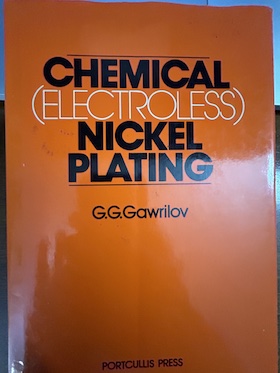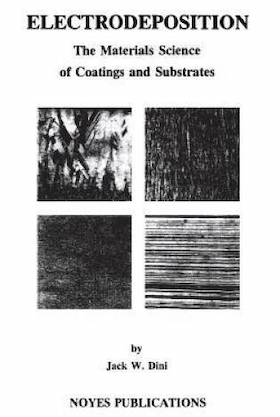
-----
Electroless Nickel plating on NiCr
by G. G. Gawrilov

on eBay or Amazon
or AbeBooks
(affil link)
Q. Hello everyone,
First experience with electroless nickel. In my shop I need to cover with nickel a very small area on a larger piece of NiCr steel. Few microns required.
I have bought a commercial solution that is reported to work between 90 to 95 °C. After some initial positive tests on various steel parts (mainly C45 / 1045 medium carbon steel) with a deposition of up to 0.75 microm/min @ 95 °C and progressively less by reducing the bath temperature, I'm having trouble treating the desired part. There is practically no deposition, just some yellow stain.
After some tests, I concluded that the problem may be the very low surface/volume ratio. In fact, my container is a 1 liter borosilicate beaker [beakers on
eBay
or
Amazon [affil link] while the exposed surface is only 4x3 mm or 12 mm2 (the real part is a big piece of metal masked to prevent nickel deposition).
Following some suggestions read here, I have used a piece of bare steel as a dummy and perhaps it seem to work (I still need to measure the thickness deposited), though this is an enormous waste of the solution.
However, I have tested a piece of masked steel, previously nickel plated, with no dummy, with an exposed area of few mm2 and it worked just fine (why?).
The second problem is the temperature of the bath when the piece is submerged. Accordingly to the supplier, I need to dip the part only when the bath has reached the optimum temp however, because the piece is large and cold, and because I should keep the the ratio S/V small (low solution volume), when I dip it , I lose at least 10-15 °C.
Should I dip the piece at low solution's temp and let the temperature rise to 95 °C ?
Should I switch to electro-galvanic deposition? (I choose EN because I need a very smooth deposit).
Any suggestion is appreciated.
- Rome Italy
A. Hello Guy. I am not convinced that low surface area to volume is the main problem. I think you need to Wood's Nickel Strike the area before you do the electroless nickel. And when the part is so large that it reduces the temperature of the solution by 10-15 °C, I think you're going in the wrong direction trying to reduce the solution volume :-)
Luck & Regards,

Ted Mooney, P.E. RET
Striving to live Aloha
finishing.com - Pine Beach, New Jersey
Ted can be retained for immediate
answers or long term project help
March 2022
Q. Hi Ted, many thanks for your reply. What exactly is the Wood's strike?
Guy Big [returning]- Rome Italy
March 7, 2022
by Jack Dini

on eBay or Amazon
or AbeBooks
(affil link)
A. Hi again Guy. Wood's Nickel Strike is an electrolytic process developed by Don Wood (dec.) of Hill-Cross Company [a finishing.com supporting advertiser] to allow plating onto stainless steel. It's a nickel bath which is very high in hydrochloric acid and low in nickel concentration so that as it dissolves the oxide layer on the stainless it simultaneously applies a thin layer of nickel. We linked your question to our search engine results, and the best evidence to my knowledge of its value is reported by Jack Dini in his book "Electrodeposition"
Luck & Regards,

Ted Mooney, P.E. RET
Striving to live Aloha
finishing.com - Pine Beach, New Jersey
Ted can be retained for immediate
answers or long term project help
March 2022
Q. Hi again Ted,
I'm now experimenting the galvanic nickel deposition to see if it works.
I have just ordered a couple of bottles of Wood Strike from a local dealer.
Is this solution also useful for galvanic nickel deposition as I'm still facing troubles on this NiCr steel ?
Thanks
Guy
- Rome Italy
March 7, 2022
A. Hi. Wood's Nickel is one type of galvanic nickel. The thing that is special about it is that it can dissolve the oxidized surface on the NiCr because of the strong HCl and the low concentration of nickel. Other galvanic nickel plating solutions have too little acid and too much nickel to solve the oxide problem.
Luck & Regards,

Ted Mooney, P.E. RET
Striving to live Aloha
finishing.com - Pine Beach, New Jersey
Ted can be retained for immediate
answers or long term project help
March 2022
⇩ Related postings, oldest first ⇩
Q. I am being asked to electroless plate Ni on a NiCr sputtered alloy. I have tried a 30% HCl dip to strip off the native oxide but the EN won't initiate. The features are small, 3 µm openings through a spun on resist pattern. I have also tried a buffered HF solution (10:1) to expose the Ni in the NiCr alloy but to no avail.
Suggestions anyone?
Patrick FranklinIndigo Systems - Santa Barbara, California
2001
A. Try next:
(1) Reverse etching in sulfuric acid for 60s, switch polarity and
(2) Direct etching for 30s
(3) Reverse for 30s
(4) Direct for 10s.
If you have Nickel Strike, plate 2-3 min. rinse and put in EN
Reverse mean parts is connected to positive pol on rectifier
Mico [last name deleted for privacy by Editor]- Vancouver, BC, Canada
A. Hi. Nico is probably right, but I'd omit the "If you have" from his instruction of "If you have Nickel Strike" :-) The beauty of nickel strike / Wood's Nickel is that oxides sometimes form virtually instantaneously on chrome-bearing steels, and the Wood's Nickel replaces them rather than just removing them only to have form instantaneously again.
Luck & Regards,

Ted Mooney, P.E.
Striving to live Aloha
finishing.com - Pine Beach, New Jersey
Ted can be retained for immediate
answers or long term project help
Q, A, or Comment on THIS thread -or- Start a NEW Thread

